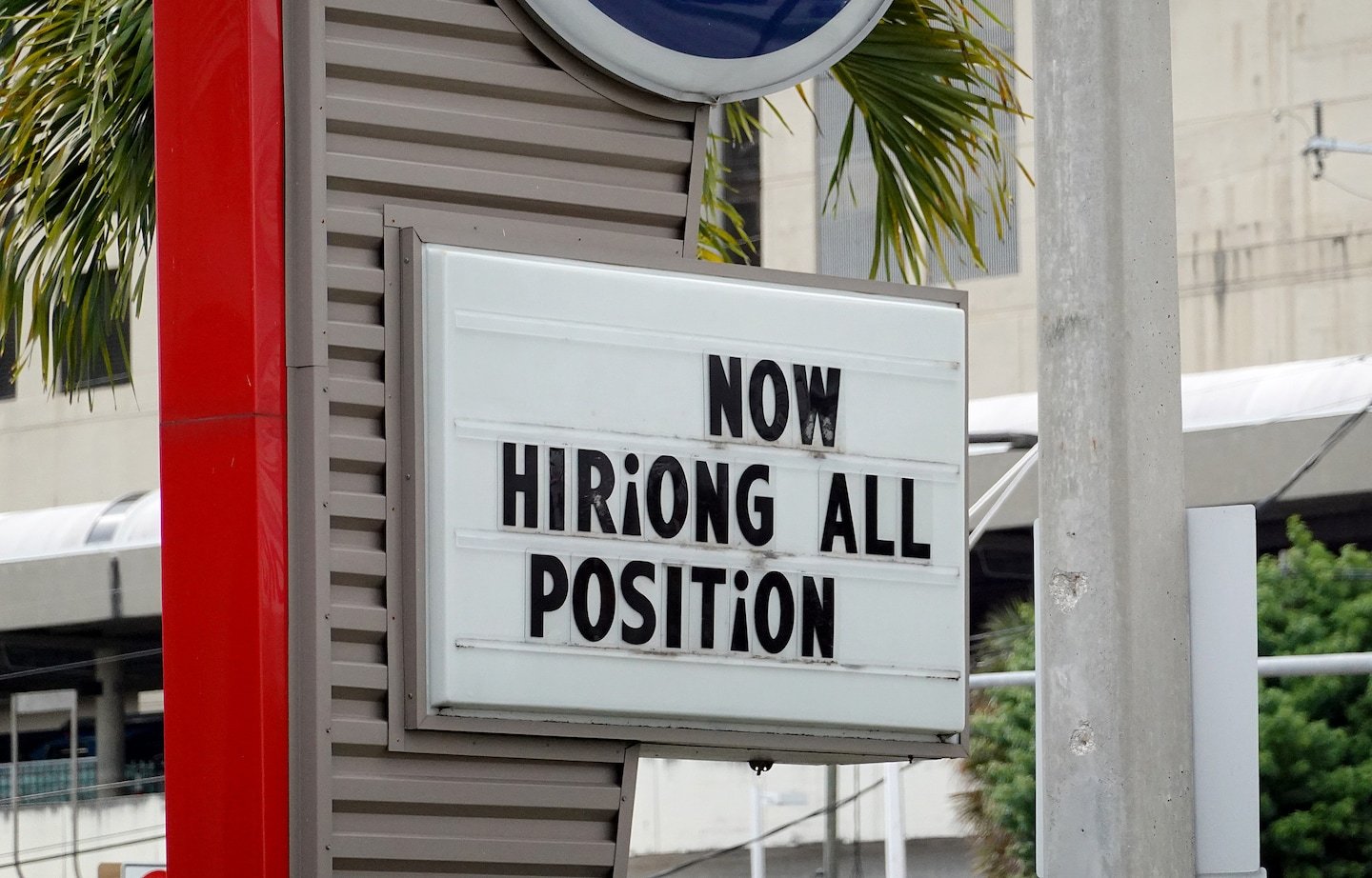A record number of workers are quitting their jobs, empowered by new leverage – The Washington Post
The number of people quitting their jobs has surged to record highs, pushed by a combination of factors that include Americans sensing ample opportunity and better pay elsewhere.
Some 4.3 million people quit jobs in August — about 2.9 percent of the workforce, according to new data released Tuesday from the Labor Department. Those numbers are up from the previous record, set in April, of about 4 million people quitting, reflecting how the pandemic has continued to jolt workers’ mind-set about their jobs and their lives.
The phenomenon is being driven in part by workers who are less willing to endure inconvenient hours and poor compensation, who are quitting instead to find better opportunities. According to the report, there were 10.4 million job openings in the country at the end of August — down slightly from July’s record high, which was adjusted up to 11.1 million, but still a tremendously high number. This gives workers enormous leverage as they look for a better fit.
Get the day’s most important and interesting stories in a brief text message.
The implications of this shift could be long-lasting.
Normally, churn in the labor market reflects workers feeling more confident in the economy, willing to risk the security of their current job for a new opportunity. But the scale of these new changes — and the larger economic transitions they signal — has added an element of unpredictability. Workers and employers are reassessing their approaches amid a continually evolving public health threat.
Many businesses say they are finding this new dynamic challenging as they struggle to retain employees and find qualified candidates for open positions. Some businesses have found success by increasing pay and compensation.
Warehouse jobs — recently thought of as jobs of the future — are suddenly jobs few workers want
On the other hand, many workers, particularly those who lost jobs early in the pandemic, might need to find ways to retrain and add skills for new careers. Many workers have decided that low-paying jobs, or work that requires a long commute, are not desirable, but they could need new skills to fill jobs they desire more.
These changes are happening rapidly. The Labor Department data shows that about 892,000 workers in restaurants, bars and hotels quit in August, as well as 721,000 workers in retail. An additional 706,000 employees in professional business services and 534,000 workers in health care and social assistance also left jobs.
In almost every sector tracked by the Bureau of Labor Statistics, workers are quitting at or near the highest levels on record, going back to when tracking began in 2001. But even in a time of records, the speed of quitting among low-wage service workers stands out. Almost 2 in 5 workers (38 percent) who quit in August worked in retail or in restaurants and hotels. Quitting in manufacturing is not as high as in the low-pay service sectors, at 2.5 percent, but it has accelerated every bit as quickly as factories race to poach one another’s workers and increase production as supply-chain issues reshuffle the global manufacturing landscape.
Nick Bunker, economist at the jobs site Indeed, said the numbers were a reflection of the options workers have in the current economic market, with job openings outnumbering unemployed workers and people reevaluating what they want to do.
The high level of people quitting their jobs was probably due in large part to people leaving jobs to take other positions, although the data does not specify why people are quitting and where they are ending up.
“This really elevated rate of people quitting their job is a sign that workers have lots of confidence and they have relatively stronger bargaining positions than they’ve had in the past,” Bunker said. “There’s lots of demand, and people are seizing that opportunity and quitting their job.”
Jennifer Booth quit her information technology job at a national retailer in August, after months of working as many as 90 hours a week during the pandemic to help the company revamp its e-commerce system. The final straw came when the chain began moving hundreds of finance and tech jobs overseas, she said.
“To be working as much as humanly possible for all of 2020 and then get told we don’t matter? It felt like crap,” said Booth, 48, of Denver.
She began looking for a new job in January and briefly considered moving to Hawaii.
Child-care workers are quitting rapidly, a red flag for the economy
By July, she had found a new position with comparable pay at an insurance company. Two months in, she said she feels appreciated: The workplace is more collaborative and there are opportunities to move up.
“I feel so doggone lucky to have found something better,” she said. “I lived through hell for 18 months until I finally realized I don’t have to do that anymore. There are brighter pastures.”
Julia Pollak, a labor economist at ZipRecruiter, said the Labor Department data was another indication of how the pandemic has shaken up the labor market.
“All this talk about the ‘great resignation’ and the epic labor shortage of 2021 is not hyperbole,” she said.
The pandemic has been extremely disruptive to the labor market, though the pressures have changed over the past 18 months. In March and April 2020, more than 20 million workers lost their jobs — at one point more than 1 million workers were being laid off each day — because companies shuttered with the crashing economy. The jobless rate has improved since the spring of 2020, but leverage shifted from employers to employees as the pandemic helped draw attention to the plight of low-wage workers. There are a number of other factors that workers are weighing, including health concerns amid the rise of the coronavirus’s delta variant, as well as uneven access to child care.
While job offerings were more consistent before the pandemic, the range of questions employers are facing, such as how they deal with remote and flexible work, compensation and bonus packages, gives workers a broader range of positions to choose from.
“People are sorting themselves into conditions that suit them best,” Pollak said. “And that’s why we’re seeing this huge reshuffling. People are voting with their feet.”
America’s unemployed send a message: They’ll go back to work when they feel safe — and well-compensated
ZipRecruiter’s data shows that workers are increasingly looking to change industries from sectors such as retail and hospitality to others where work is more likely to be able to be done remotely, such as customer service. Some 20 percent say they are now looking for remote work options because of the pandemic; another sizable chunk of workers say they are looking for more flexibility.
Whitney Morency, 29, of Queens is one of those people. She only recently found a new position, as a corporate assistant at Macy’s, after losing her job in retail for the company Kate Spade early on in the pandemic.
She said the job-openings numbers belied the challenges for many workers, like her, who were hoping to change industries — a shift influenced by the pandemic but on her wish list from before, too.
“A lot of companies were hiring but seemed like they weren’t taking anyone in,” she said, saying that in more than a year of scanning job sites such as Indeed and Monster, she felt that the level of experience companies were asking for was higher than it used to be, a change she believed was because of corporations dialing back remote training.
The Labor Department data adds more context to a surprising aspect of the pandemic: Workers are emerging with more choices as many employers say they are struggling to staff up.
The labor market is still down about 5 million jobs from where it was before the pandemic, and that does not even account for the job growth that would have normally occurred over that span.
Employers in many industries, including hotels, restaurants and construction, have complained about the difficulty of hiring workers after the pandemic upended the labor market and made many people less willing to take low-wage jobs.
Republican officials in many states sought to address the issue by curtailing federal unemployment benefits over the summer, but those cuts seem to have done little to resolve the issue. In September, the country added just 194,000 jobs despite the record numbers of openings.
The most important news stories of the day, curated by Post editors and delivered every morning.
By signing up you agree to our Terms of Use and Privacy Policy




